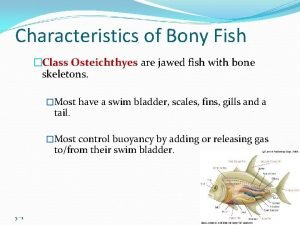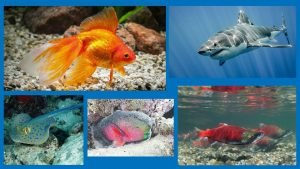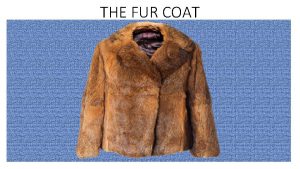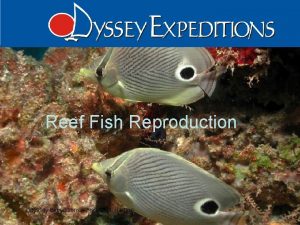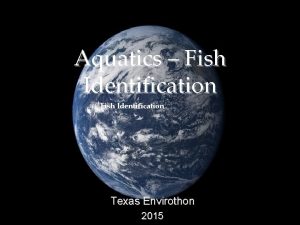Envirothon Fish Mrs Weimer Reproduction External Reproduction Fish







































- Slides: 39

Envirothon Fish Mrs. Weimer

Reproduction • External Reproduction


Fish Communities • Coldwater Fishes Group of fishes that thrives and reproduces in water temperatures less than 70 degrees. The preferred temperature range for these fishes is between 50 and 65 degrees. • Coldwater Fishes— Brook Trout, Slimy Sculpin, Rainbow Trout • Coldwater Transition Fishes— Brown Trout, Blacknose Dace, Longnose Dace

• Coolwater Fishes Group of fishes that thrives and reproduces in water temperatures less than 80 degrees but warmer than 60 degrees. The preferred temperature range for these fishes is between 65 and 70 degrees. • Coolwater Fishes— Northern Pike, Muskellunge, Fallfish, Creek Chub, Northern Hogsucker, Tessellated Darter, Yellow Perch • Coolwater Transition Fishes— Walleye, Smallmouth Bass, Chain Pickerel, Grass Pickerel, Rock Bass, Redbreast Sunfish, Margined Madtom

• Warmwater Fishes Group of fishes that thrives and reproduces in water temperatures warmer than 80 degrees. The preferred temperature range for these fishes is between 70 and 85 degrees. • Warmwater Fishes— Largemouth Bass, Bluegill, Common Shiner, Channel Catfish, Yellow Bullhead, Carp

Sight • • • Do not have a lens; must move back and forth Can see in all directions, except directly Can see in 3 -d (binocular and monocular) Near sighted Can see in color

Hearing • Can hear low frequency waves • Also the lateral line; tiny pores on it running head to tail to signal changes – Helps schooling fish move together

Smell and taste • 10, 000 taste buds all over mouth, inside it, and on the barbels of catfish • Can sense the water from smell – Catfish smell out the water that they were spawned in and return every year

American Eel • • • The American eel has a slender snakelike body that is covered with a mucous layer, which makes the eel appear to be naked and slimy despite the presence of minute scales American eels hunt at night, and during the day they hide in mud, sand or gravel very close to shore, roughly 5 to 6 feet under. They feed on crustaceans, aquatic insects, small insects, and probably any aquatic organisms that they can find and eat.


American Shad • Largest of the herrings, is the most abundant anadromous fish on the east coast of the United States • They spend most of their lives in saltwater but spawn in freshwater (Anadromous) • A female releases 100, 000 to 600, 000 eggs into the water to be fertilized by several males. Adult shad return to the ocean soon after spawning.

Atlantic Sturgeon • • Sturgeons are long lived with an average lifespan of 50 to 60 years, but some individuals have lived to be over 100. They are sexually late maturing, and are often 15 to 20 years old before they have their first spawn. Even then, they don’t spawn every year. Sturgeons require exacting conditions for spawning, including the proper photo period in Spring, clean water with shallow rock or gravel substrate for the eggs to adhere, and the proper water temperature and flow to oxygenation the eggs. If the required conditions are not met, spawning will not occur.

Blacknose dace • Blacknose dace live in streams and rivers across eastern N. A, where they feed upon small invertebrates and microscopic biological matter. • They may provide forage for larger fish. • Minnow Family

Bluegill Spawning season for bluegills starts late in May and extends into August. The peak of the spawning season usually occurs in June in waters of 67 to 80°F In the SUNFISH family Live in habitats like Largemouth bass

Bowfin or Dogfish When performing low-level physical activity, bowfins obtain more than half of their oxygen from breathing air -living fossil (one of the oldest fish) -can go to the surface to suck air (like the gar fish)-it’s swim bladder leads to the mouth

Brown bullhead • • Species of bullhead catfish They stay on the bottom Up to 18 inches Feed on the bottom

Brook Trout Salmon Family PA State Fish -Mouth extends past eyes -prefer cold waters -can produce 4000 eggs

Brown Trout -Not native to PA -More difficult to catch than brook trout -cool waters (50 -60 degrees) -Somewhat tolerant to acidity (like brook trout) -4000 to 12000 eggs produced

Chain Pickerel -Pike Family -Feeds on smaller fish until it can ambush larger fish -BONY fish -30 inches long -hides in weedy habitats -solitary predators -can outstrip their food source if placed in a lake or pond -6000 to 8000 eggs (sticky)

Channel Catfish -NA most numerous catfish =Keen sense of smell and sight with olfactory senses -not native-brought here from great lakes -2000 to 70000 eggs per female -prefers deeper waters -bottom feeder

Creek Chub VERY small-up to 12 inches only Carnivorous -minnow family -Scales do not appear until the fish is 26 mm long, leaving 30 -mm-long individuals having small scales with few circuli. -Major growth occurs during the first year, often jumping by over 50– 70 mm in one year. -Males grow far more quickly than females, allowing maturity to occur at one to one and a half years of age.

Common Carp Lives in eutrophic waters (enriched waters with nutrients) Worlds most invasive species -can lay over 1, 000 eggs per year -omnivorous and will tear up the bottom of the rivers

Flathead Catfish Second largest catfish in NA Males build nests for spawning Flatheads grow to a length of 155 cm (61 in) and may weigh up to 56 kg (123 lb), making it the second largest North American catfish

Greenside darter Percid Family Life expectancy 3 -5 years Greenside darters typically live for three to five years, Grow to a maximum of 132 mm standard length and sexually mature at one to two years of age. Greenside darters are reproductively active from February to April in the Midwest and Southeastern United States. Spawning occurs over algae- or moss-covered rocks Females linger in pools below the riffle and move into a male's territory when ready to spawn.

Largemouth Bass Sunfish family The largemouth bass is an olive-green fish, in the North East right after iceout, it most often has a gray color, The upper jaw (maxilla) of a largemouth bass extends beyond the rear margin of the orbit. In comparison to age, a female bass is larger than a male. A maximum recorded overall length of 29. 5 in (75 cm)[11] and a maximum unofficial weight of 25 pounds 1 ounce (11. 4 kg).

Longnose Dace Freshwater minnow Cool water streams Sexual maturity age 2 Lifespan 3 -5 years

Mottled Sculpin Breeding season 3 mths Clutch size 8 -148 eggs Males tend to the nest

Muskellunge Largest member of pike family Ambush predator Can take on prey up to 30% their own length

Northern pike Easiest fish to catch Has light spots on dark background Has 5 or fewer pores on underside of mouth -muskies have more than 5

Paddlefish Related to sturgeons Have not really evolved since dinosaurs Among longest lived fishes freshwater

Rainbow Trout Salmon Family Coldwater Between 1 -5 lbs

Rock Bass Sunfish family Similar to smallmouth bass Can thrive many places

Sea lamprey No jaw of bony structures Possess skeleton made of cartilage Predators/invasive species

Slimy Sculpin Nocturnal Poor swimmers Used as an indicator Species for acidification

Smallmouth Bass Sunfish family Up to 27 inches and 12 lbs Males smaller Found in clearer water than largemouth Intolerant to pollution Female can lay 21000 eggs-males tends to them

Striped bass Long lived: 30 + years Spawning in freshwater Adults live in salt water

Walleye Named bc eyes point outward Excellent vision-in bottoms of lakes in summer See very well in turbid waters 31 inches and 20 lbs average

White Sucker “sucks” up organic matter On floor Avg-12 -16 inches up to 6 lbs Bottom feeder
 One fish two fish red fish blue fish ride
One fish two fish red fish blue fish ride Brett weimer
Brett weimer Melissa weimer
Melissa weimer Brett weimer
Brett weimer One fish, two fish, blowfish, blue fish
One fish, two fish, blowfish, blue fish Placoid scales meaning
Placoid scales meaning They are mrs garcia and mrs castro
They are mrs garcia and mrs castro Mrs. darling was ___________ of mrs. s.
Mrs. darling was ___________ of mrs. s. They are mrs garcia and mrs castro
They are mrs garcia and mrs castro Sexual reproduction and asexual reproduction
Sexual reproduction and asexual reproduction Sexual asexual venn diagram
Sexual asexual venn diagram Binary fission in bacteria
Binary fission in bacteria External-external trips
External-external trips Is croaker a cartilaginous fish
Is croaker a cartilaginous fish Fish reproductive system
Fish reproductive system Character of bony fish
Character of bony fish Bony vs cartilaginous fish
Bony vs cartilaginous fish A big fish swims up and swallows a small fish at rest
A big fish swims up and swallows a small fish at rest Fillet fish market form
Fillet fish market form Indirect characterization
Indirect characterization A package for mrs. jewls conflict
A package for mrs. jewls conflict Mr. gallon
Mr. gallon Mrs skeletal
Mrs skeletal Mrs mutner
Mrs mutner Mrs c gren
Mrs c gren Mrs elliott a teacher at durham school of the arts
Mrs elliott a teacher at durham school of the arts Mrs.sparks
Mrs.sparks A chip of glass ruby memorandum 2020
A chip of glass ruby memorandum 2020 Eric birling
Eric birling Mrs 17
Mrs 17 Traditional bento
Traditional bento 10 marker structure
10 marker structure Mrs eaves font
Mrs eaves font Mrs wild going wild
Mrs wild going wild Edith eaton
Edith eaton Pat's ending balance on his debit card
Pat's ending balance on his debit card The fur coat characters
The fur coat characters Grade 8 science water systems quiz
Grade 8 science water systems quiz Mrs frisby and the rats of nimh setting
Mrs frisby and the rats of nimh setting Mrs chous ap biology
Mrs chous ap biology















